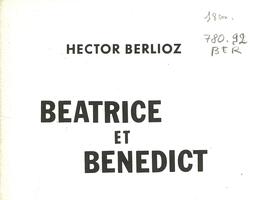Béatrice et Bénédict
Opéra-comique en deux actes
After the Tempest and King Lear overtures, Roméo et Juliette (“symphonie dramatique”) and a group of Hamlet pieces, Berlioz turned to Shakespeare for the last time in 1860 with Béatrice et Bénédict, a two-act opéra-comique based on Much Ado About Nothing. The work was commissioned by Edouard Bénazet, director of the casino in Baden-Baden, for the new theatre he was having built there. Berlioz conducted the first performance for its opening on 9 August 1862. He wrote the libretto himself, boiling the original plot down to “a caprice” in which “Béatrice and Bénédict, who absolutely hate each other, must fall in love”. He borrowed large excerpts from the play, particularly for the spoken dialogues, and added lines of his own for the vocal numbers. He had previously been inspired by Shakespeare’s tragedies, but now, turning to a comedy, he reconnected with the spirit of Benvenuto Cellini. We can feel the pleasure he took in composing the genre pieces (Sicilienne, no. 2 bis; Chœur à boire, no. 9; Chœur lointain, no. 12, with guitar accompaniment; Marche nuptiale, no. 13) and in creating with his inimitable palette a dreamlike atmosphere (Nocturne, no. 8). He also amused himself respecting the conventions of the two-part bel canto aria, with a slow cantabile followed by a fast cabaletta (Héro’s aria, no. 3, Béatrice’s aria, no. 10) and the fugue (Épithalame grotesque, no. 6). One would have expected Berlioz to close his dramatic output with his monumental work Les Troyens, but no, the curtain came down on a comedy.

